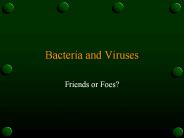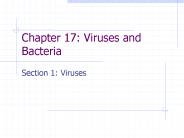Chemotrophic PowerPoint PPT Presentations
All Time
Recommended
TCA Cycle = Citric Acid Cycle = Krebs Cycle. TCA (TriCarboxylic Acid) produces citrate (aka citric acid) as an intermediate in the cycle; ...
| PowerPoint PPT presentation | free to view
From complete oxidation of the large number of. reduced ... Cu2 (cupric) accepts 1 electron and is reduced to Cu (cuprous) Coenzyme Q (CoQ or Ubiquinone) ...
| PowerPoint PPT presentation | free to view
Chemotrophs Rely on Phototrophs. Aerobic Respiration (chemotrophic energy metabolism) ... C6H12O6 6O2 6CO2 6H2O. C's of glucose are released to atmosphere ...
| PowerPoint PPT presentation | free to view
Bacteria and Viruses Friends or Foes?
| PowerPoint PPT presentation | free to download
Title: PowerPoint Presentation Author: THunt Last modified by: THunt Created Date: 10/8/2004 11:57:02 PM Document presentation format: On-screen Show
| PowerPoint PPT presentation | free to view
Evolution of Earth
| PowerPoint PPT presentation | free to view
Chapter 27 Prokaryotes and the Origins of Metabolic Diversity
| PowerPoint PPT presentation | free to view
Archaebacteria are believed to be the ancestors of both Eubacteria ... Disease. Syphilis, gonorrhea, tuberculosis, strep throat, botulism, etc. Food Spoilage ...
| PowerPoint PPT presentation | free to view
PROKARYOTES 20.2 Introduction to Prokaryotes First discovered by Anton van Leeuwenhoek in 1683 (invention of light microscope) Are prokaryotes No nucleus Exist ...
| PowerPoint PPT presentation | free to view
Asexual Reproduction Binary Fission Conjugation Sexual Reproduction A ... adult stage, they are usually ... Armadillos B. Bass C. Catfish D. Ducks A. mechanical B ...
| PowerPoint PPT presentation | free to view
PATOGENESIS PATOGENESIS (pathogenesis): Urut-urutan peristiwa dari patogen dalam menimbulkan penyakit. Rangkaian pembentukan penyakit dengan tahapan proses yang ...
| PowerPoint PPT presentation | free to download
If the bacteria possesses a cell capsule, it will retain a pink color. ... live in hot, acidic environments such as hot springs and hydrothermal ...
| PowerPoint PPT presentation | free to download
Title: No Slide Title Author: The Weber Family Last modified by: rabideau Created Date: 5/28/1995 4:18:48 PM Document presentation format: On-screen Show
| PowerPoint PPT presentation | free to download
Identifying Bacteria Cell Wall. Based on Thickness. Gram Bacteria ... Facultative Anaerobes. Reproduction. Speed. Two Methods. Binary Fission. Conjugation ...
| PowerPoint PPT presentation | free to view
... Plants and Animals ... are in Domain Eukarya The 6 Kingdoms For now we will only introduce the Important characteristics ... are different kinds) ...
| PowerPoint PPT presentation | free to view
The Microbiology of Bioremediation and Biodegradation. By Puan N Abdullah. Energy Requirements ... Organisms are divided into major categories according to ...
| PowerPoint PPT presentation | free to view
Diseases: tetanus, botulism, gonorrhea, chlamydia, tuberculosis, etc., etc., etc. ... Diseases: tetanus, botulism, gonorrhea, chlamydia, tuberculosis, etc. ...
| PowerPoint PPT presentation | free to view
Fermentation: Catabolism of carbon in the absence of a terminal electron acceptor (like O2) for electron transport chain Photosynthesis and Autotrophy I ...
| PowerPoint PPT presentation | free to download
Do not have a membrane-bound nucleus ... Tadpole. Many sided (helical or cube-like) Viruses. D. Vary in size (20 - 400 nanometers) ...
| PowerPoint PPT presentation | free to view
Chloroplasts and Mitochondria (organelles) are believed to originally be ... Evidence:Mitochondria have their own DNA separate ... Facultative. Reproduction ...
| PowerPoint PPT presentation | free to view
Lack specialzed organelles as seen in eukaryotes. Have ... CELL WALL (though it is not made of cellulose like plant cell walls) ... YES/NO: FACULTATIVE ANEROBES ...
| PowerPoint PPT presentation | free to view
Carolus Linnaeus (1707 - 1778) was the first to establish the hierarchical ... 4 morphotypes (Solidary, Capsular, Filamentous, Filamentous with specialized cells) ...
| PowerPoint PPT presentation | free to view
Chapter 17: Viruses and Bacteria Section 1: Viruses Viruses The word virus comes from the Latin language Poison About 100 years ago in what is now Ukraine, an ...
| PowerPoint PPT presentation | free to download
Purple (Non)Sulfur Bacteria Purple Bacteria All are proteobacteria Most are facultative aerobes: Perform aerobic respiration with O2 Perform photosynthesis without O2 ...
| PowerPoint PPT presentation | free to view
Photosynthesis: light reactions and carbon-assimilation ... Stoichiometry of CO2 assimilation in the Calvin cycle. for every three CO2 molecules fixed: ...
| PowerPoint PPT presentation | free to view
Heterocyst and nitrogenase synthesis is repressed when combined nitrogen is already present. Lack of combined nitrogen stimulates heterocyst and nitrogenase ...
| PowerPoint PPT presentation | free to download
A Round-Table Discussion held during the 10th FEBS Meeting in Paris ... Twee. Nederlandse onderzoeksgroepen (Hagen, TUD en Albracht, UvA) werken nog steeds aan ...
| PowerPoint PPT presentation | free to view
Biological Classification Why Do We Classify Organisms? Biologists group organisms to organize and communicate information about their diversity, similarities and ...
| PowerPoint PPT presentation | free to download
Incorporation of Molecular Biology, Bioinformatics, Genomics ... New bioinformatics exercises will be. based on web-based sources, or. downloadable software ...
| PowerPoint PPT presentation | free to download
Phylogenetic relationships between unicellular aquatic organisms
| PowerPoint PPT presentation | free to view
Sulfurous hot springs, very salty lakes, and in ANAEROBIC environments, such as ... Rod (bacillus) Spiral. The shape may determine the GENUS/GROUP name ...
| PowerPoint PPT presentation | free to view
Sludge is readily biodegradable under this regime and generates sizeable quantities of methane gas, which can be burnt to provide onsite electricity.
| PowerPoint PPT presentation | free to download
Obligate aerobes require O2. Facultative anaerobes can ... Obligate aerobe. Obligate anaerobe. Toxic Forms of Oxygen. Singlet oxygen (1O2) very reactive ...
| PowerPoint PPT presentation | free to view
SJF 04-2003. Carbon Sequestration. Geoscience Controls on Macroengineering Problems ... of AGI gravity, water saturation, wettability, permeability, and CO2 slug size ...
| PowerPoint PPT presentation | free to view
Macromolecules (proteins, nucleic acids, carbohydrates, and lipids) ... may be flagellated or ciliated (Paramecium), lack cell walls, some are parasitic. ...
| PowerPoint PPT presentation | free to view
Title: PowerPoint Presentation Author: Jason E. Meade Last modified by: Martinez, Maria O Created Date: 4/12/2002 12:43:12 AM Document presentation format
| PowerPoint PPT presentation | free to download
ecology chapters 3,4,5 & 6
| PowerPoint PPT presentation | free to view
General Biology Unit Four Objective One
| PowerPoint PPT presentation | free to view
Microbial physiology ... release energy Energy Production 3 Biochemical Mechanisms Utilized ... DNA DNase Proteins Protease removes a Hydrogen ...
| PowerPoint PPT presentation | free to download
Scientific Method
| PowerPoint PPT presentation | free to view
Title: Environmental Science Author: shappellr Last modified by: Bashab Banerjee Created Date: 1/29/2004 7:53:23 PM Document presentation format: On-screen Show (4:3)
| PowerPoint PPT presentation | free to view
Marine Biome ... Ocean Biomes
| PowerPoint PPT presentation | free to view
7th grade Life Science MCAS review
| PowerPoint PPT presentation | free to download
Digestion and Nutrition Chapter 32
| PowerPoint PPT presentation | free to download
Title: PowerPoint Presentation Author: Jason E. Meade Last modified by: Tara Roper Created Date: 4/12/2002 12:43:12 AM Document presentation format
| PowerPoint PPT presentation | free to download
Chapter 5: Microbial Metabolism
| PowerPoint PPT presentation | free to view
Food Chains, Food Webs, and the Transfer of Energy Autotrophs A groups of organisms that can use the energy in sunlight to convert water and carbon dioxide into ...
| PowerPoint PPT presentation | free to download
How Ecosystems Work Energy flow Cycling of materials How ecosystems change The nitrogen cycle: Plants obtain nitrogen from the soil Animal obtain nitrogen from eating ...
| PowerPoint PPT presentation | free to view
GHSGT Science Review Domain 2: Ecology Food Chains, Food Webs, and the Transfer of Energy Ppt. 2
| PowerPoint PPT presentation | free to download
Ecology Ecology is the study of interactions among organisms and between organisms and their environment. Ecology: Levels of Organization Individual ...
| PowerPoint PPT presentation | free to download
Bacteria consist of only a single cell, but don't let their small size and seeming simplicity fool you. They're an amazingly complex and fascinating group of creatures.
| PowerPoint PPT presentation | free to view
Energy flow in ecosystems
| PowerPoint PPT presentation | free to download
The Science of Life * * Biology The Study of Life Life arose more than 3.5 billion years ago First organisms (living things) were single celled Only life on Earth ...
| PowerPoint PPT presentation | free to view
... Catabolism Anabolism Coupled Reactions Nutrition Phototroph Chemotroph Organotroph Lithotroph Chemolithotroph Macronutrients Carbon Nitrogen P, S, K, Mg, Ca ...
| PowerPoint PPT presentation | free to download
Chapter 1 Biology and You Section 1 Themes of Biology Bio = _____ - ology = _____ Freancesco redi Bio = _____ - ology = _____ Cellular ...
| PowerPoint PPT presentation | free to view
Title: Energy flow in ecosystems Author: Bessey Hall Mac Lab Last modified by: Norman Herr Created Date: 6/2/1998 8:41:43 AM Document presentation format
| PowerPoint PPT presentation | free to download
























































